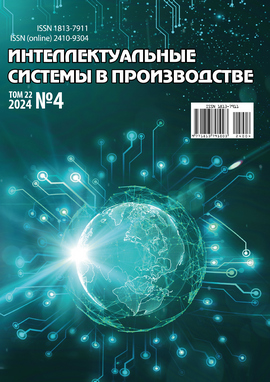Graph-theoretical Approach to the Analysis of the Variability of Russian Fairy Tales
DOI:
https://doi.org/10.22213/2410-9304-2024-4-90-97Keywords:
information system «Folklore», discriminant analysis, plot variability, graph-theoretic model, russian fairy taleAbstract
The paper considers the graph-theoretical approachused to analyze Russian folk fairy tales.Such a formal structuredescription of the analyzed folklore texts is based on the patterns outlined by V. Ya. Propp in a number of his works and in his famous book “Morphology of a Fairy Tale”, in particular. This allows systematization and analysis of the key events occurring in texts. The vertices of the graph-theoretical model represent the fairy talecharacters being classified into certain fixed groups, while the edges indicate meetings between the characters, accompanied by the actions significant for the fairy tale plot. Using the example of the text «Tereshechka» from the collection by A. M. Afanasyev, it is shown how the model is built and the numerical graphcharacteristics are calculated. For this purpose, the tools of the «Folklore» information system are also used. By means of this program, you can not only store textcollections and their graph-theoretical models, but also create formal structures, perform their visualization, aggregation and comparisonautomatically. Discriminant analysis showed that according to formal parameters it is possible to identify the plot of a fairy tale about a brave fellow, rejuvenating apples and living water. The Wilks' Lambda coefficient value is 0.0275781 (less than 0.05), which indicates the good quality of the classifier. Based on this, it should be concluded that graph-based mathematical modelscan be used to systematize and compare the plots of Russian folk tales. This opens up prospects for studying both the fairy talevariability and identifying the most significant and typical plots for a certain geographical area or time period.References
Рогов А. А., Кулаков К. А., Москин Н. Д. Программная поддержка в решении задачи атрибуции текстов // Программная инженерия. 2019. Т. 10. № 5. С. 234-240. DOI: 10.17587/prin.10.234-240.
Щеголева Л. В., Лебедев А. А., Москин Н. Д. Методы анализа данных в задаче разграничения фольклорных и авторских текстов // Вопросы языкознания. 2020. № 2. С. 61-74. DOI: 10.31857/ S0373658X0008823-4.
Zhang T., Gao Yu., Qiu L., Chen L., Linghu Q., Pu Sh. Distributed time-respecting flow graph pattern matching on temporal graphs // World Wide Web. 2020. Vol. 23. No. 1. Pp. 609-630.
Ma Yu., Yuan Ye., Liu M., Wang G., Wang Y. Graph simulation on large scale temporal graphs // GeoInformatica. 2020. Vol. 24. No. 1. Pp. 199-220.DOI: 10.1007/s10707-019-00381-y.
Debrouvier A., Parodi E., Perazzo M., Soliani V., Vaisman A.A modeland query language for temporal graph databases // The VLDB Journal. 2021. Vol. 30. No. 5. Pp. 825-858.DOI: 10.1007/s00778-021-00675-4.
Bozhenyuk A., Knyazeva M., Bozheniuk V., Kacprzyk J. Fuzzy clique set determination method as an example of fuzzy temporal graph invariant // Advances in Intelligent Systems and Computing. 2021. Vol. 1306. Pp. 1-9. DOI: 10.1007/978-3-030-04164-9_8.
Афанасьев А. М. Народные русские сказки А. Н. Афанасьева: в 3 т. М. : Государственное издательство художественной литературы (Гослитиздат), 1957.
Нечай Ю. П., Поверенная А. А. Языковые средства реализации сюжета русской волшебной сказки // Гуманитарные и социальные науки. 2022. Т. 90, № 1. С. 83-88. DOI 10.18522/2070-1403-2022-90-1-83-88.
Гаазе-Рапопорт М. Г. Поиск вариантов в сочинении сказок // Зарипов Р. Х. Машинный поиск вариантов при моделировании творческого процесса. М. : Наука, 1983. С. 213-223.
Пропп В. Морфология сказки. Л. : Academia, 1928. 152 с.
Бобунова М. А., Хроленко А. Т. Русская народно-поэтическая речь на фоне иноэтнических традиций: кросскультурный аспект // Вестник славянских культур. 2021. № 61. С. 226-237. DOI: 10.37816/2073-9567-2021-61-226-237.
Сравнительный указатель сюжетов. Восточнославянская сказка. Л. : Наука, 1979. 437 с.
Андреев Н. П. Указатель сказочных сюжетов по системе Ааарне. Л. : Изд-во Государственного русского географического общества, 1929. 120 с.
Куран М. С. Специфика анализа сказки в семиотическом аспекте // Мир науки, культуры, образования. 2010. № 5. С. 238-240.
Праведников С. П. Лингвофольклористика в научном пространстве гуманитаристики и вузовском учебном плане // Профессорский журнал. Серия: Русский язык и литература. 2021. №4(8). С. 42-45. DOI: 10.18572/2687-0339-2021-4-42-45.
Downloads
Published
How to Cite
Issue
Section
License
Copyright (c) 2024 Николай Дмитриевич Москин, Александр Александрович Лебедев

This work is licensed under a Creative Commons Attribution 4.0 International License.


